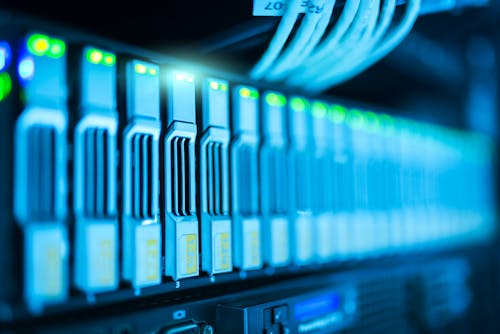Data Centers from a digital view
Data centers are increasingly important infrastructure structures worldwide. It is these centers that contain the information and operating base of today's world of commerce, work, and life information for much of the world's population. Increasingly, data and information are an asset of individuals and businesses, and as such, their value and the concerns surrounding them have increased significantly. The rules for collecting and processing information are increasingly present, and the lack of security associated with data can lead to the bankruptcy of large companies, as we have seen in the past. Therefore, its conception is quite different from a traditional warehouse.
At first glance a data center is nothing more than the warehouse where a large amount of IT equipment is put to work, but if we take a closer look, there are several points where special attention is required and that make these buildings different from traditional warehouses.

Security
A data center usually has a few more levels of security than a traditional warehouse. Access to the complex is restricted and to the building even more, with everything being monitored remotely with detection systems and security personnel. For the intrusion scenario, there are physical active systems that block the entrance and exit of certain areas of the complex and the building, such as metal barriers.
Besides the security levels associated with the building and physical access, there are also security levels associated with the stored information. These are quite complex and increasingly "intelligent", being guaranteed only to authorized personnel and with various levels of verification and control.
As far as fires are concerned, a data center has a great electrical risk and as such the whole complex must be protected. Detection must be by heat and smoke, but since data centers have their own internal air flow, detectors cannot be located on just one level, but several levels and several locations according to what is expected to be the smoke flow and the temperature gradient. Extinguishing should be done primarily without water, at least in some areas of the building, to reduce costs and damage to the entire IT infrastructure and data center core.
Energy
A data center is a major source of energy consumption. All IT infrastructure needs power to function, but not only that. It needs constant, quality, and uninterrupted power. A data center can consume 25x more energy than a traditional logistics warehouse for the same area. You can usually estimate the power required by the area of IT equipment or the number of existing server racks.
In addition to the large power required, it is also necessary that the power is not interrupted. Data centers must be located near high-voltage power sources to cope with the large electrical demand. In addition, they must have various levels of electrical redundancy, with UPS's that can handle short term power outages, and diesel or gas generators that can handle the data center for the long term. Due to the large amount of energy required for a data center to function, it is common to find these buildings associated with solar or wind power plants, to minimize the needs and dependence on buying energy from the grid.
HVAC
The cooling system of the IT server area is something quite important within a data center. As you can understand, a large part of the energy consumed by the building is transformed into heat that must be removed from the building. The energy required to remove that heat can be almost 50% of the energy required to power all the other equipment in the building, and as such, this point is very important in the design, not only for the proper functioning of the building, but also to reduce its operating costs.
The cooling is done using chillers, but the air flow inside the server zone is something that should be properly analyzed so that there is an efficient cooling of the equipment zone, and that the humidity and pressure are controlled. The vapor barrier should also be kept close to the exterior surfaces. There are several possible ways to do heat extraction, but the heat flow inside the space is something that must be analyzed in 3 dimensions, usually using a CFD analysis. The cooling system of the IT server area is something quite important within a data center. As you can understand, a large part of the energy consumed by the building is transformed into heat that must be removed from the building. The energy required to remove that heat can be almost 50% of the energy required to power all the other equipment in the building, and as such, this point is very important in the design, not only for the proper functioning of the building, but also to reduce its operating costs.
The cooling is done using chillers, but the air flow inside the server zone is something that should be properly analyzed so that there is an efficient cooling of the equipment zone, and that the humidity and pressure are controlled. The vapor barrier should also be kept close to the exterior surfaces. There are several possible ways to do heat extraction, but the heat flow inside the space is something that must be analyzed in 3 dimensions, usually using a CFD analysis.
Architecture
All the energy and information received and transmitted by a data center needs to pass outside the complex. That's why its location is very important, especially in terms of its proximity to major telecommunications networks and large-capacity power grids. It may also need to be close to other centers that work in conjunction with the data center in question.
Unlike a traditional logistics building, a data center does not need work lighting inside. The server area is only accessed by a small group of people and for operations of short duration. As such natural light is not important in this type of building, and roof skylights, which are placed for lighting reasons, can be eliminated. Also loading docks, although necessary, do not have the same use as a traditional logistics building and as such can be placed in a much lower quantity and ratio than a traditional warehouse.
In general, a data center has 3 important and distinct points in its conception. The server room, consisting of racks that provide the building with the large computational and memory capacity, are the building's important core. The large amount of power that the building consumes needs to be supplied from multiple sources to create multiple redundancies in the event of a power failure. To remove the large amount of heat generated by the equipment requires HVAC systems with a detailed analysis of the heat flows in the server room. These three points, because of their importance, represent more than 50% of the costs of a data center.


